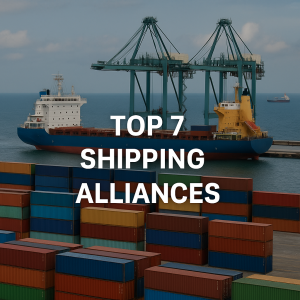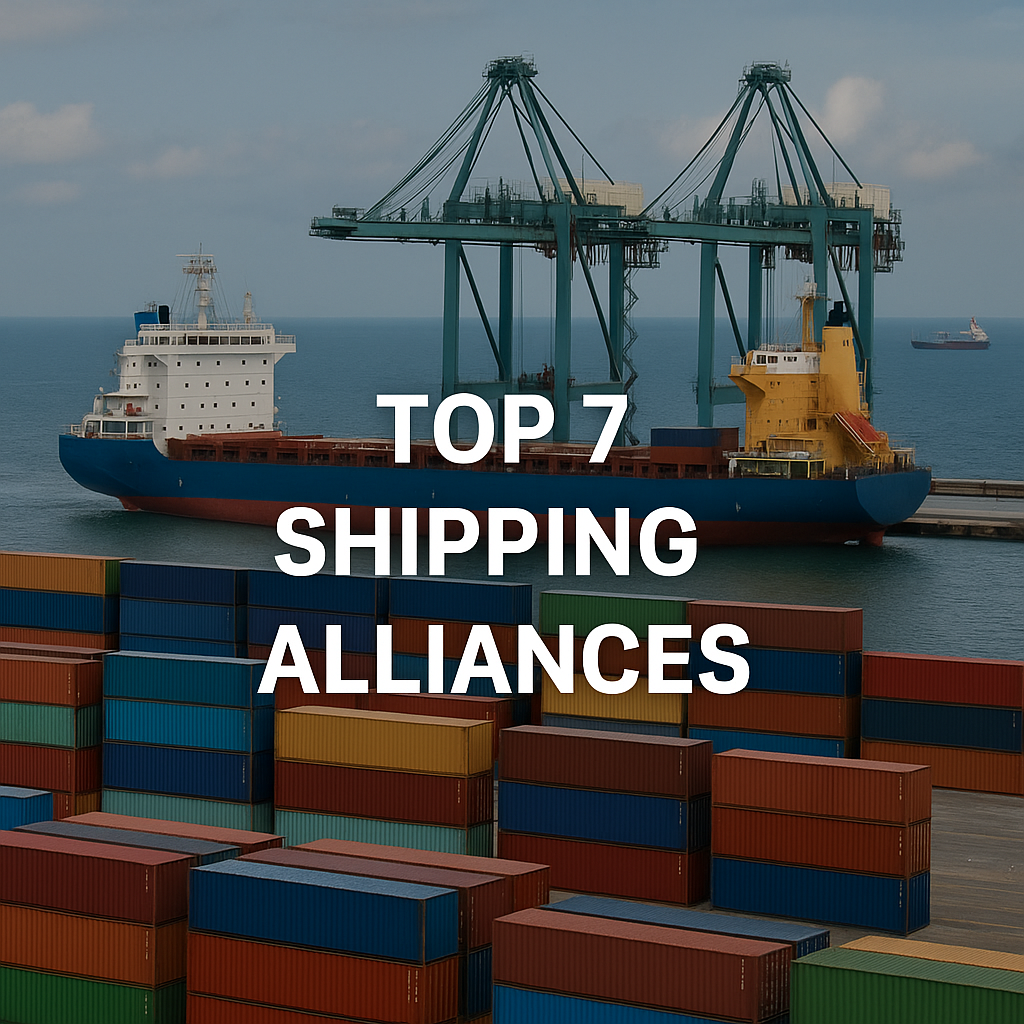Discover the top 7 shipping alliances transforming the global maritime industry. Explore their impact, technology, challenges, and future prospects in this insightful educational guide.
Beyond Competition — The Power of Collaboration
If you have ever tracked a container ship on MarineTraffic or studied global port calls, you will notice a fascinating pattern. Many of the world’s biggest vessels — from 20,000-TEU giants to specialized feeders — do not sail alone. They sail in carefully orchestrated alliances, where multiple shipping companies share vessels, routes, and networks.
This is the power of shipping alliances — cooperative frameworks that shape more than 80% of the world’s container trade.
These alliances — a kind of “maritime joint venture” — allow carriers to coordinate schedules, pool capacity, and improve vessel utilization, while reducing emissions and costs. For maritime professionals, port operators, or policy-makers, understanding how these alliances function is crucial to appreciating modern supply chains and port economics.
Let’s dive in.
Why Shipping Alliances Matter in Modern Maritime Operations
Shipping alliances matter because they strike a balance between competition and collaboration. Here is why:
✅ Network Coverage: An alliance can cover hundreds of ports, providing global reach no single carrier could manage alone.
✅ Efficiency: By sharing vessels, operators achieve higher load factors and fewer empty sailings.
✅ Environmental Benefits: Fewer blank sailings mean fewer carbon emissions per transported container, contributing to IMO decarbonisation targets.
✅ Resilience: During crises — such as COVID-19 or the 2023 Panama drought — alliances can adjust schedules faster than independent lines.
The UNCTAD Review of Maritime Transport (2023) reports that over 80% of global container capacity is deployed within alliance structures. For ports, terminals, and maritime employees, this creates both opportunities and challenges.
Key Technologies and Developments Driving Change
Modern shipping alliances would be unthinkable without technology. Here’s how they work smarter:
- Integrated Scheduling Platforms: Shared digital planning allows partners to coordinate slots and terminal windows.
- Big Data and AI: Predictive analysis helps manage vessel arrival times, especially across alliances.
- Port Community Systems: Standardised EDI (electronic data interchange) between alliances and ports reduces errors and boosts turnaround speed.
- Environmental Monitoring: Many alliances share carbon-intensity data, helping each partner comply with IMO’s CII (Carbon Intensity Indicator).
Lloyd’s List Intelligence and DNV’s shipping sustainability research underline how alliances rely on these data systems to maintain service levels and regulatory compliance.

The Top 7 Shipping Alliances in the World
Below, we break down the most influential shipping alliances and their member companies.
2M Alliance
Perhaps the most famous, the 2M Alliance brings together Maersk and MSC, two of the world’s biggest shipping lines. Established in 2015, this alliance covers major east-west trades between Asia, Europe, and North America.
✅ Fleet Strength: Over 200 vessels, many above 18,000 TEU.
✅ Unique Features: Uses advanced slow-steaming schedules and optimized transshipment hubs.
✅ Sustainability: Joint carbon emissions data sharing helps achieve IMO 2030 targets.
In 2023, Maersk announced plans to gradually dissolve 2M by 2025, which will redefine the container market.
👉 Maersk Alliance Announcements
Ocean Alliance
Launched in 2017, the Ocean Alliance includes COSCO Shipping, CMA CGM, Evergreen, and OOCL. Together, they deploy over 300 vessels covering more than 40 trade loops.
✅ Network: Asia–Europe, transpacific, and Asia–Mediterranean.
✅ Innovations: COSCO’s fleet upgrades include LNG-ready ships and shore-power retrofits.
✅ Environmental Focus: Joint fuel-optimisation programs with Evergreen to cut sulphur emissions.
👉 CMA CGM Sustainability Initiatives
THE Alliance
Formed by Hapag-Lloyd, Yang Ming, Ocean Network Express (ONE), and HMM, THE Alliance controls an extensive east-west network.
✅ Fleet: Around 250 ships, with several ultra-large container vessels (ULCVs) exceeding 20,000 TEU.
✅ Resilience: Proven adaptability during COVID-19 to maintain service levels.
✅ Green Moves: Members coordinate scrubber retrofits and EEDI (Energy Efficiency Design Index) compliance.
THE Alliance was praised in the Journal of Maritime Policy & Management (2023) for handling port congestion through dynamic vessel-sharing.
Gemini Cooperation
In January 2024, Maersk and Hapag-Lloyd announced the Gemini Cooperation, an alliance reshaping global trades after the expected breakup of 2M.
✅ Vision: 290 vessels with advanced digitised schedule sharing.
✅ Technology: Full use of AI route planning and predictive weather routing.
✅ Sustainability: 100% of Gemini’s fleet will be EEXI compliant by 2025.
This new cooperation demonstrates how the alliance model is evolving beyond its original structures.
CKYHE Alliance (historical)
While no longer active today, the CKYHE Alliance (Cosco, K Line, Yang Ming, Hanjin, and Evergreen) was a major player from 2014–2016.
✅ Contribution: Created many of today’s route templates still used in the Ocean Alliance.
✅ Legacy: Introduced standard slot-sharing practices still studied in maritime training programs.
For maritime historians, CKYHE remains a critical case study of how alliances evolve, merge, and sometimes dissolve.
OCEANX
Emerging in 2023 as a cooperative platform among mid-sized carriers, OCEANX focuses on regional trades in Asia and the Middle East.
✅ Innovative Edge: Shared feeder networks and digital slot booking.
✅ Resilience: Smaller alliances like OCEANX fill gaps where global alliances cannot.
✅ Environmental Push: Supports the IMO GHG strategy for 2050.
This is a reminder that regional shipping alliances are as vital as the global ones.
FEALink
A developing alliance among carriers trading between Far East–Africa–Latin America, FEALink is still maturing but shows enormous potential.
✅ Market Niche: Addresses underserved emerging-market trades.
✅ Technology: Integrated EDI and cargo tracking for remote ports.
✅ Future: Could transform southern hemisphere maritime corridors.
Challenges and Solutions
Regulatory Scrutiny
Alliances often face competition law reviews, as seen with the EU’s Consortia Block Exemption Regulation (CBER). To balance market power, regulators monitor alliances strictly.
Operational Complexities
Coordinating port calls, cargo flows, and ship rotations across partners is challenging. Digital twins, real-time vessel monitoring, and blockchain platforms help smooth these operations.
Sustainability Pressures
New IMO rules (e.g., CII and EEXI) mean alliances must plan greener ships and carbon-neutral fuels together. This joint action is vital for decarbonising the maritime sector.
Geopolitical Risks
Events like the Red Sea disruptions or pandemic lockdowns test alliance resilience. Robust contingency planning and adaptive slot management are essential.
Case Studies and Real-World Examples
COVID-19 Pandemic
When the pandemic struck, THE Alliance coordinated blank sailings to stabilise rates and avoid excess capacity, which protected shipping markets from chaos.
Panama Canal Drought 2023
As lower water levels hit Panama, Ocean Alliance carriers rerouted vessels through the Suez, showing alliances’ flexibility to maintain trade flow.
Gemini Cooperation
Maersk and Hapag-Lloyd’s new Gemini agreement shows alliances adapting to future decarbonisation targets while preserving service integrity.
Future Outlook
According to UNCTAD and Clarksons Research, alliances will remain the backbone of container shipping, but expect changes:
✅ More flexible, digitalised cooperation
✅ Regional alliances alongside global giants
✅ Increased focus on biofuels, hydrogen, and green corridors
✅ Tighter antitrust oversight, especially in Europe and the U.S.
✅ Integration with smart port systems for seamless supply chains
Alliances will shape not just routes, but ports, seafarer training, and even maritime education.
FAQ
What is a shipping alliance?
A voluntary agreement between shipping lines to share vessels and coordinate schedules.
Are alliances legal?
Yes, but under strict antitrust frameworks in most regions.
Do alliances hurt competition?
They can, if poorly regulated. That’s why antitrust authorities watch closely.
How do alliances help the environment?
They improve vessel utilisation and reduce unnecessary sailings, cutting emissions.
What happens if an alliance dissolves?
Members usually form new partnerships or go solo, adjusting their service patterns.
Can regional alliances compete with global ones?
Yes, especially on niche trades where flexibility matters.
Will alliances still exist in 10 years?
Highly likely, but probably with greener ships and smarter data-sharing.
Conclusion: Collaboration Sailing Ahead
Shipping alliances are more than commercial agreements — they are the backbone of the world’s container trade. From 2M to OCEANX, these partnerships help keep global goods flowing, support port development, and drive maritime decarbonisation.
For maritime students, professionals, and policy-makers, understanding alliances is vital to navigating the future of supply chains. As shipping strives to go greener and smarter, alliances will continue to chart the course of modern seafaring.
If you’d like, I can help convert this content into a training module or infographic for even easier learning — just say the word! 🌍

